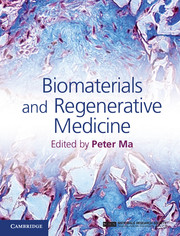Book contents
- Frontmatter
- Contents
- List of contributors
- Preface
- Part I Introduction to stem cells and regenerative medicine
- 1 Embryonic stem cells
- 2 Induced pluripotent stem cells
- 3 Connective tissue stem and progenitor cells
- 4 Hematopoietic stem cells and their niches
- 5 Using biomaterials for fetal stem cell isolation, expansion and directed-differentiation
- 6 The hematopoietic stem cell niche
- Part II Porous scaffolds for regenerative medicine
- Part III Hydrogel scaffolds for regenerative medicine
- Part IV Biological factor delivery
- Part V Animal models and clinical applications
- Index
- References
5 - Using biomaterials for fetal stem cell isolation, expansion and directed-differentiation
from Part I - Introduction to stem cells and regenerative medicine
Published online by Cambridge University Press: 05 February 2015
- Frontmatter
- Contents
- List of contributors
- Preface
- Part I Introduction to stem cells and regenerative medicine
- 1 Embryonic stem cells
- 2 Induced pluripotent stem cells
- 3 Connective tissue stem and progenitor cells
- 4 Hematopoietic stem cells and their niches
- 5 Using biomaterials for fetal stem cell isolation, expansion and directed-differentiation
- 6 The hematopoietic stem cell niche
- Part II Porous scaffolds for regenerative medicine
- Part III Hydrogel scaffolds for regenerative medicine
- Part IV Biological factor delivery
- Part V Animal models and clinical applications
- Index
- References
Summary
Introduction
Stem cells are defined by their unique ability to self-renew and produce progeny that differentiate into specialized cells. Naturally occurring stem cells are usually broken down into three principal categories. Embryonic stem cells (ESCs) are derived from the inner cell mass of a preimplantation embryo and are considered pluripotent, meaning able to produce cell types of all three germ layers. Second, adult somatic stem cells exist at a very low frequency in almost all tissues and organs of the body and are usually considered lineage-restricted to the subset of cell types that make up their tissue of origin. Lastly, fetal stem cells can be obtained from various fetal tissues, including primordial germ cells, blood, liver, bone marrow and amniotic fluid, as well as extra-embryonic tissues such as the placenta and umbilical cord. In terms of multipotentiality these fetal stem cells lie somewhere between ESCs and more committed adult somatic stem cells. A new fourth, artificially generated type of stem cell now exists, namely the so-called induced pluripotent stem (iPS) cell, which results from the transcriptional reprogramming of a terminally differentiated somatic cell. Each one of these stem cell types has advantages and disadvantages in cell-based therapies and undoubtedly no one cell type will fit all applications. For example, ES cells are attractive because of their inherent plasticity, but their derivation elicits ethical concerns and the likelihood of forming teratomas after transplantation makes them, for now, a therapeutic dead end. Adult somatic stem cells, like bone marrow mesenchymal stromal cells (BM-MSCs) are being used clinically [45, 62], but their applications are restricted by limited proliferative capacity in culture and a predisposition to differentiate down primarily mesenchymal lineages. iPS cells have been shown to be genetically unstable and also have the potential to form teratomas after transplantation [33], especially if the efficiency of the differentiation protocols is not optimized. Fetal stem cells can be isolated from two distinct sources, the fetus proper and the extra-embryonic support tissues such as the amniotic fluid, placenta, and umbilical cord (especially Wharton’s jelly) [1]. Isolating stem cells from the fetus is replete with moral, ethical, and legal concerns and will therefore not be discussed further here. The use of fetal stem cells from extra-embryonic tissues, on the other hand, elicits no ethical or moral concerns because their isolation does not put a developing fetus at risk.
- Type
- Chapter
- Information
- Biomaterials and Regenerative Medicine , pp. 64 - 79Publisher: Cambridge University PressPrint publication year: 2014



